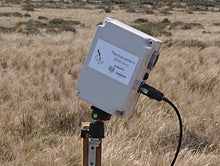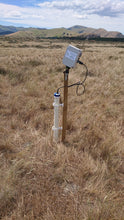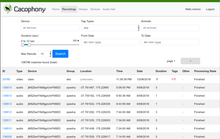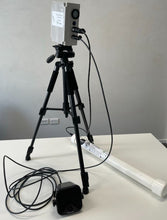
Note: A lower cost camera with more functionality is now available.
The Thermal Predator Camera automatically detects movement and uploads videos to the cloud where they are analysed using machine vision algorithms to detect predators and birds.
The videos and statistics on the animals found can be viewed on the cacophony portal.
This provides the easiest, most effective and most cost effective way of monitoring predator numbers. These claims are backed up by the results from a Lincoln University study into the effectiveness of these thermal cameras. This study showed that these cameras are
- 3.5x more sensitive than infrared trail cameras for possum detection
- 200x faster to analyse
- 8x cheaper per detection
Another study showed that the cameras are 5-20 times more sensitive for detecting rats.
The Department of Conservation have published a paper comparing thermal and trail cameras. This looks at the total cost of ownership and recommends situations where one type of camera should be used over the other.
At the moment the model can automatically identify:
- possums
- rodents (rats and mice)
- cats
- hedgehogs
- mustelids (stoats, ferrets and weasels)
- birds
- leporidae (rabbits and hares)
- wallabies
- penguins
- vehicles.
- humans
The accuracy of the identification varies with distance of the animal from the camera. Generally there is very high accuracy from 3-8m. This article describes the accuracy of the thermal camera machine vision in more detail.
This thermal camera can work online or offline. If the camera is within cell phone coverage and has a modem then the videos will be uploaded to the cloud as they are recorded. If the camera is not within cell phone range, or the there is no modem then the videos are stored on the camera and will be uploaded, either when the camera is bought back into cell phone reception of WIFI, or they can be wirelessly transferred from the camera to a phone using app called sidekick (read more about sidekick).
The camera includes a year's worth of cloud storage. Additional storage and connectivity can be bought separately. This video shows what it's like to use the Cacophony Portal.
The camera can be powered by a battery, mains power supply, or solar. The power supply, batteries and charger are each sold separately. It is recommended that the camera is mounted on a secure tripod or post. These are sold separately. The battery, charger and tripod/post can also be bought as a combo, saving money.
If you want to use solar to power the camera this can be set up using off the shelf components. This document describes a solar set up for the thermal camera.
"I really appreciate the ongoing tech support and modifications you’re providing to our team. It is hugely valued and a great comfort when spending up large (for conservation budgets) on new tech tools." Matt Maitland, Senior Ranger Open Sanctuaries
Specifications
| Specification | |
| Operating voltage | 5-13.3V (battery or mains) |
| Sensor |
FLIR lepton 3.5 |
| Field of view | 56° HFOV, 71° diagonal |
| Resolution | 160 x 120 |
| Frame rate | 9 Hz |
| Range |
~10-20m |
| Connectivity |
USB modem or Wi-Fi |
| Storage | 8GB |
View the thermal camera accessories.
Download the thermal camera manual.
Check out blog posts about the thermal camera and videos about and from the thermal camera
Here is a a draft protocol for how to use the thermal cameras to monitor predators over an area.
The camera hardware and software, along with the machine vision algorithms and cloud storage portal have all been developed by The Cacophony Project, a not for profit organisation. A proportion of the proceeds will be donated to The Cacophony Project so they can continue to develop technology to help New Zealand become predator free.







